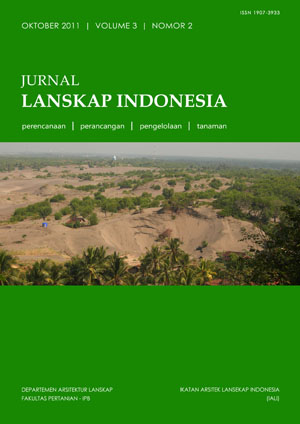PERENCANAAN LANSKAP WISATA PESISIR BERKELANJUTAN DI TELUK KONGA, FLORES TIMUR, NUSA TENGGARA TIMUR
Abstract
Konga Bay is a beautiful natural coastal landscape enriched with local culture and vernacular architecture which is still preserved. There are two objectives of this study, firstly is to propose alternative plan of coastal tourism interpretation trail for KongaBay to support its landscape conservation. Second objective is to plan Konga Bay landscape –in lines with sustainable tourism development, to be a beautiful, pleasant, and long-lasting tourism landscape; as well as giving better living opportunity for
local community. The study applied descriptive-quantitative method to assess coastal environmental quality, potency of coastal tourism development, acceptability level and local community development in tourism. Those three assessments were integrated to obtained land suitability zone for tourism which was subsequently developed to spatial and circulation programs of coastal tourism in order to plan coastal tourism
interpretation trail and sustainable coastal tourism landscape as well. Tourism zone consisted of (1) main zone for aquatic and terrestrial tourism areas and (2) supporting zone contains welcome and transition areas. Circulation of coastal tourism comprises primary, secondary, tertiary, and tsunami evacuation circulations. Coastal tourism interpretation plan provides three alternatives of interpretative trail. Development plan of Konga Bay coastal tourism landscape includes aquatic and terrestrial tourism landscape.
Downloads
This journal permits and encourages authors to post items submitted to the journal on personal websites or institutional repositories both prior to and after publication, while providing bibliographic details that credit, if applicable, its publication in this journal. However, after the article is submitted and published in this journal, it is fully copyrighted by the Jurnal Lanskap Indonesia or JLI. If excerpts from other copyrighted works are included, the author must obtain written permission from the copyright owner and give credit to the source in the article. Then, the writer or reader is allowed to copy, share, and redistribute articles/material in any form. But it must still include the appropriate source and credit because the article in this journal is licensed by Creative Commons Attribution 4.0 International License (CC BY 4.0).
I. Proposed Policy for Journals That Offer Open Access
Authors who publish with this journal agree to the following terms:
- Authors retain copyright and grant the journal right of first publication with the work simultaneously licensed under a Creative Commons Attribution License that allows others to share the work with an acknowledgement of the work's authorship and initial publication in this journal.
- Authors are able to enter into separate, additional contractual arrangements for the non-exclusive distribution of the journal's published version of the work (e.g., post it to an institutional repository or publish it in a book), with an acknowledgement of its initial publication in this journal.
- Authors are permitted and encouraged to post their work online (e.g., in institutional repositories or on their website) prior to and during the submission process, as it can lead to productive exchanges, as well as earlier and greater citation of published work (See The Effect of Open Access).
II. Proposed Policy for Journals That Offer Delayed Open Access
Authors who publish with this journal agree to the following terms:
- Authors retain copyright and grant the journal right of first publication, with the work after publication simultaneously licensed under a Creative Commons Attribution License that allows others to share the work with an acknowledgement of the work's authorship and initial publication in this journal.
- Authors are able to enter into separate, additional contractual arrangements for the non-exclusive distribution of the journal's published version of the work (e.g., post it to an institutional repository or publish it in a book), with an acknowledgement of its initial publication in this journal.
- Authors are permitted and encouraged to post their work online (e.g., in institutional repositories or on their website) prior to and during the submission process, as it can lead to productive exchanges, as well as earlier and greater citation of published work (See The Effect of Open Access).



























